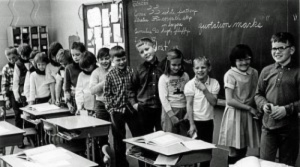The Blue Eyes-Brown Eyes Exercise
On April 4, 1968 Martin Luther King Jr. was assassinated while fighting a world fraught with inequality and discrimination. One day later a 3rd grade Iowa teacher, Jane Elliott, decided to teach her students a lesson they would not soon forget; a lesson regarding the power of discrimination. Elliott knew that merely lecturing her kids about the effects of discrimination would not suffice; she wanted them to experience it firsthand.

Elliott began the experience with her 3rd graders by creating discrimination and initialized the blue eyes/brown eyes exercise. On the first day of the exercise she informed her students that the students with blue eyes were superior to those with brown eyes. Elliott gave the blue-eyed students privileges, which included longer recess and seconds for lunch. The brown-eyed students however, had their privileges taken away, and were publicly ridiculed for their flaws. By the end of the day the new classroom hierarchy had transformed the demeanor of the students. Elliott’s 3rd graders had suddenly become conscious of one another’s eye color, and being called brown-eyed had become a derogatory statement.
The next day Elliott performed the same exercise, but instead, she informed the class that she had been mistaken and it was truly the brown-eyed students who were superior. The same results began to occur as the previous day. The brown-eyed students felt supreme and looked down upon those with blue eyes. The blue-eyed students lost their prowess and confidence from the day before and even began receiving lower test scores that day than they ever had previously.
At the conclusion of Elliott’s exercise the students had firsthand experience of the effects of discrimination. After a discussion with her 3rd graders about what had happened over the course of the exercise the students displayed their new understanding of what discrimination really felt like. The class stated that as the superior group they had felt like kings who reigned over the less superior, however, when they were discriminated against the students felt demoralized. One girl said that when she had been discriminated against she had gone home that day and truly felt hate for the first time in her life.
Jane Elliott was able to capture the power of discrimination in her small Iowa classroom over the course of two days. She demonstrated the effects of discrimination not only on those who were discriminated against but also those who were not. A characteristic that had once meant nothing to these children became their main focus. They began to attribute the simple physical characteristic of eye color to intelligence and manners. To Elliott’s class eye color was no longer an external characteristic but rather a reflection of the type of person within.
Martin Luther King Jr.’s message of the need for equality and peace was evident in Elliott’s classroom. Her students were not the reflection of their eye color, but individuals with varying personalities, values and dreams. During the month of February, Black History Month, it is important that we reflect on the effects our own actions can have on others. From the workplace to the classroom discrimination is apart of our society. We must practice being mindful of its presence and effect to better work together without restricting borders.
To learn more about the Blue Eye/Brown Eye Exercise click here.





Leave a Reply
Want to join the discussion?Feel free to contribute!